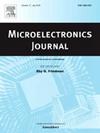SCCS: A neuromorphic architecture supporting synapse compression for converted spiking neural networks
IF 1.9
3区 工程技术
Q3 ENGINEERING, ELECTRICAL & ELECTRONIC
引用次数: 0
Abstract
Neuromorphic computing emulates the information processing of the biological brain, providing a potential solution to the memory and power consumption limitations of the traditional von Neumann architecture. However, due to immature spiking neural network (SNN) learning algorithms, many high-performance SNN applications are converted from artificial neural networks (ANNs). Existing neuromorphic hardware faces challenges in deploying converted SNNs due to limited synaptic storage and spatiotemporal traffic imbalances. Therefore, this paper proposes a novel neuromorphic architecture supporting synapse compression for converted SNNs, namely SCCS. A storage-free synaptic addressing technique minimizes the memory used for synaptic. Additionally, a multicast-supported hybrid hierarchical architecture was adopted for load balance communication. To evaluate SCCS, we developed a prototype design and synthesized it using the SMIC 55-nm low-power process. The prototype accommodates approximately 589K neurons and 130M synapses, occupying only 16 of area. The neuron and synapse density of our design remains advantageous compared to the state-of-the-art neuromorphic hardware fabricated with a 4-nm process. Our design achieves a maximum throughput of 9.6 billion spikes per second per cluster, which is nearly three times higher than similar research. Finally, we constructed an FPGA verification platform to assess performance using real-world applications.
SCCS:一种支持转换尖峰神经网络突触压缩的神经形态架构
神经形态计算模拟了生物大脑的信息处理,为传统冯·诺伊曼架构的内存和功耗限制提供了一个潜在的解决方案。然而,由于峰值神经网络(SNN)学习算法的不成熟,许多高性能SNN应用都是由人工神经网络(ann)转换而来。由于有限的突触存储和时空流量不平衡,现有的神经形态硬件在部署转换snn时面临挑战。因此,本文提出了一种新的支持转换snn突触压缩的神经形态结构,即SCCS。无存储突触寻址技术最大限度地减少了突触所使用的内存。此外,采用支持组播的混合层次结构实现负载均衡通信。为了评估SCCS,我们开发了一个原型设计,并使用中芯国际55纳米低功耗工艺合成了SCCS。该原型容纳了大约589K个神经元和130M个突触,仅占用16 mm2的面积。与采用4nm工艺制造的最先进的神经形态硬件相比,我们设计的神经元和突触密度仍然具有优势。我们的设计实现了每个集群每秒96亿个峰值的最大吞吐量,这比类似的研究高出近三倍。最后,我们构建了一个FPGA验证平台,通过实际应用来评估性能。
本文章由计算机程序翻译,如有差异,请以英文原文为准。
求助全文
约1分钟内获得全文
求助全文
来源期刊

Microelectronics Journal
工程技术-工程:电子与电气
CiteScore
4.00
自引率
27.30%
发文量
222
审稿时长
43 days
期刊介绍:
Published since 1969, the Microelectronics Journal is an international forum for the dissemination of research and applications of microelectronic systems, circuits, and emerging technologies. Papers published in the Microelectronics Journal have undergone peer review to ensure originality, relevance, and timeliness. The journal thus provides a worldwide, regular, and comprehensive update on microelectronic circuits and systems.
The Microelectronics Journal invites papers describing significant research and applications in all of the areas listed below. Comprehensive review/survey papers covering recent developments will also be considered. The Microelectronics Journal covers circuits and systems. This topic includes but is not limited to: Analog, digital, mixed, and RF circuits and related design methodologies; Logic, architectural, and system level synthesis; Testing, design for testability, built-in self-test; Area, power, and thermal analysis and design; Mixed-domain simulation and design; Embedded systems; Non-von Neumann computing and related technologies and circuits; Design and test of high complexity systems integration; SoC, NoC, SIP, and NIP design and test; 3-D integration design and analysis; Emerging device technologies and circuits, such as FinFETs, SETs, spintronics, SFQ, MTJ, etc.
Application aspects such as signal and image processing including circuits for cryptography, sensors, and actuators including sensor networks, reliability and quality issues, and economic models are also welcome.
 求助内容:
求助内容: 应助结果提醒方式:
应助结果提醒方式:


